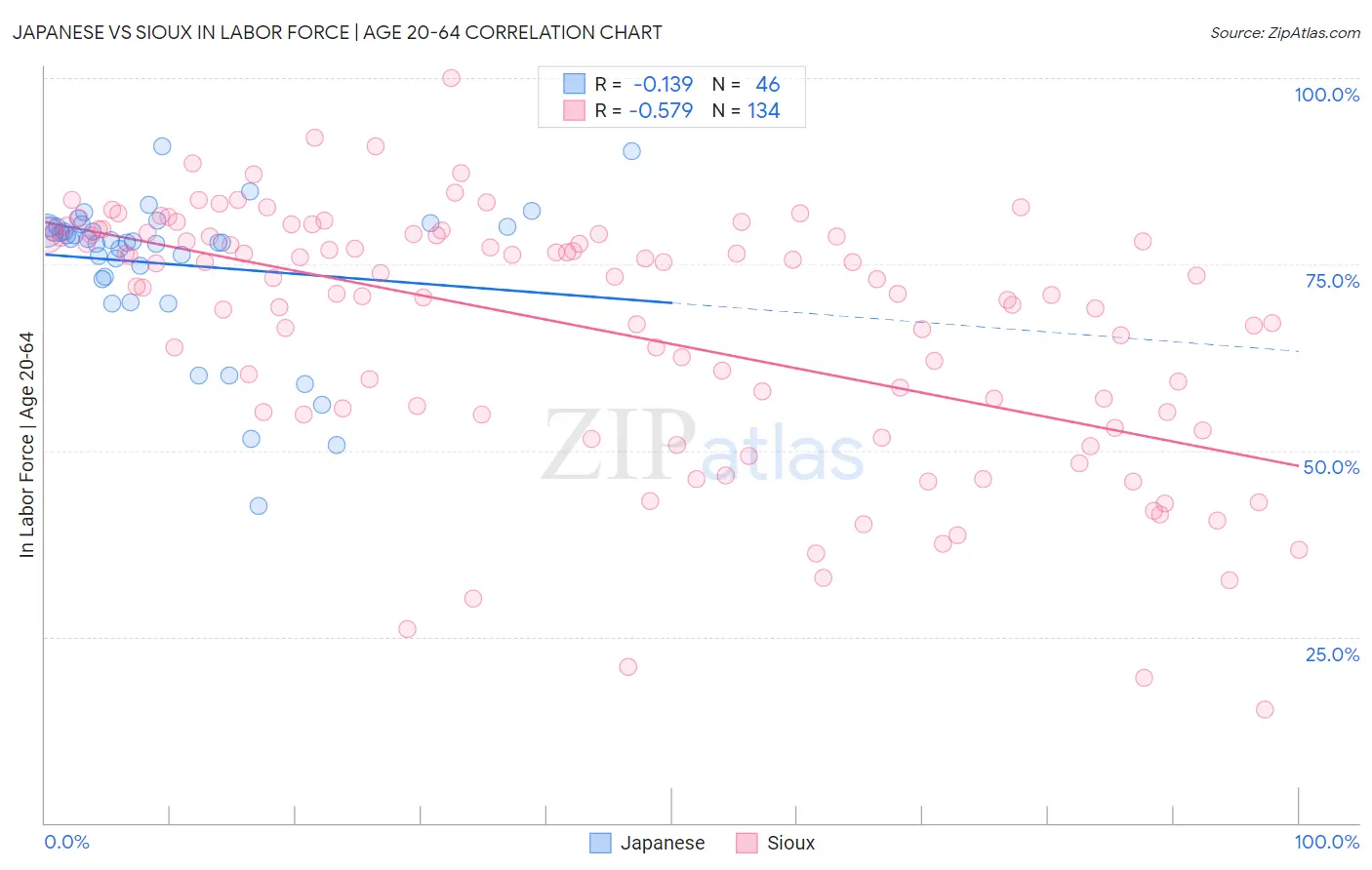Japanese vs Sioux In Labor Force | Age 20-64
COMPARE
Japanese
Sioux
In Labor Force | Age 20-64
In Labor Force | Age 20-64 Comparison
Japanese
Sioux
79.1%
IN LABOR FORCE | AGE 20-64
4.0/ 100
METRIC RATING
233rd/ 347
METRIC RANK
75.0%
IN LABOR FORCE | AGE 20-64
0.0/ 100
METRIC RATING
327th/ 347
METRIC RANK
Japanese vs Sioux In Labor Force | Age 20-64 Correlation Chart
The statistical analysis conducted on geographies consisting of 249,187,220 people shows a poor negative correlation between the proportion of Japanese and labor force participation rate among population between the ages 20 and 64 in the United States with a correlation coefficient (R) of -0.139 and weighted average of 79.1%. Similarly, the statistical analysis conducted on geographies consisting of 234,178,381 people shows a substantial negative correlation between the proportion of Sioux and labor force participation rate among population between the ages 20 and 64 in the United States with a correlation coefficient (R) of -0.579 and weighted average of 75.0%, a difference of 5.4%.

In Labor Force | Age 20-64 Correlation Summary
| Measurement | Japanese | Sioux |
| Minimum | 42.6% | 15.2% |
| Maximum | 90.8% | 100.0% |
| Range | 48.2% | 84.8% |
| Mean | 75.0% | 66.4% |
| Median | 78.2% | 72.5% |
| Interquartile 25% (IQ1) | 73.3% | 55.2% |
| Interquartile 75% (IQ3) | 80.1% | 79.0% |
| Interquartile Range (IQR) | 6.8% | 23.8% |
| Standard Deviation (Sample) | 10.0% | 17.0% |
| Standard Deviation (Population) | 9.9% | 17.0% |
Similar Demographics by In Labor Force | Age 20-64
Demographics Similar to Japanese by In Labor Force | Age 20-64
In terms of in labor force | age 20-64, the demographic groups most similar to Japanese are Guamanian/Chamorro (79.1%, a difference of 0.030%), Immigrants from Canada (79.0%, a difference of 0.040%), Lebanese (79.1%, a difference of 0.050%), Tlingit-Haida (79.0%, a difference of 0.050%), and Samoan (79.0%, a difference of 0.060%).
| Demographics | Rating | Rank | In Labor Force | Age 20-64 |
| Central Americans | 5.9 /100 | #226 | Tragic 79.1% |
| Immigrants | Western Europe | 5.9 /100 | #227 | Tragic 79.1% |
| Panamanians | 5.7 /100 | #228 | Tragic 79.1% |
| Alsatians | 5.7 /100 | #229 | Tragic 79.1% |
| Native Hawaiians | 5.6 /100 | #230 | Tragic 79.1% |
| Lebanese | 5.1 /100 | #231 | Tragic 79.1% |
| Guamanians/Chamorros | 4.5 /100 | #232 | Tragic 79.1% |
| Japanese | 4.0 /100 | #233 | Tragic 79.1% |
| Immigrants | Canada | 3.2 /100 | #234 | Tragic 79.0% |
| Tlingit-Haida | 3.2 /100 | #235 | Tragic 79.0% |
| Samoans | 2.9 /100 | #236 | Tragic 79.0% |
| Immigrants | North America | 2.9 /100 | #237 | Tragic 79.0% |
| Immigrants | Jamaica | 2.6 /100 | #238 | Tragic 79.0% |
| Welsh | 2.4 /100 | #239 | Tragic 79.0% |
| Trinidadians and Tobagonians | 2.3 /100 | #240 | Tragic 79.0% |
Demographics Similar to Sioux by In Labor Force | Age 20-64
In terms of in labor force | age 20-64, the demographic groups most similar to Sioux are Kiowa (75.0%, a difference of 0.030%), Creek (75.1%, a difference of 0.18%), Cheyenne (74.8%, a difference of 0.23%), Colville (74.8%, a difference of 0.29%), and Menominee (75.3%, a difference of 0.40%).
| Demographics | Rating | Rank | In Labor Force | Age 20-64 |
| Yakama | 0.0 /100 | #320 | Tragic 75.8% |
| Seminole | 0.0 /100 | #321 | Tragic 75.5% |
| Dutch West Indians | 0.0 /100 | #322 | Tragic 75.5% |
| Cajuns | 0.0 /100 | #323 | Tragic 75.5% |
| Choctaw | 0.0 /100 | #324 | Tragic 75.4% |
| Menominee | 0.0 /100 | #325 | Tragic 75.3% |
| Creek | 0.0 /100 | #326 | Tragic 75.1% |
| Sioux | 0.0 /100 | #327 | Tragic 75.0% |
| Kiowa | 0.0 /100 | #328 | Tragic 75.0% |
| Cheyenne | 0.0 /100 | #329 | Tragic 74.8% |
| Colville | 0.0 /100 | #330 | Tragic 74.8% |
| Paiute | 0.0 /100 | #331 | Tragic 74.7% |
| Arapaho | 0.0 /100 | #332 | Tragic 74.4% |
| Natives/Alaskans | 0.0 /100 | #333 | Tragic 73.9% |
| Apache | 0.0 /100 | #334 | Tragic 73.7% |